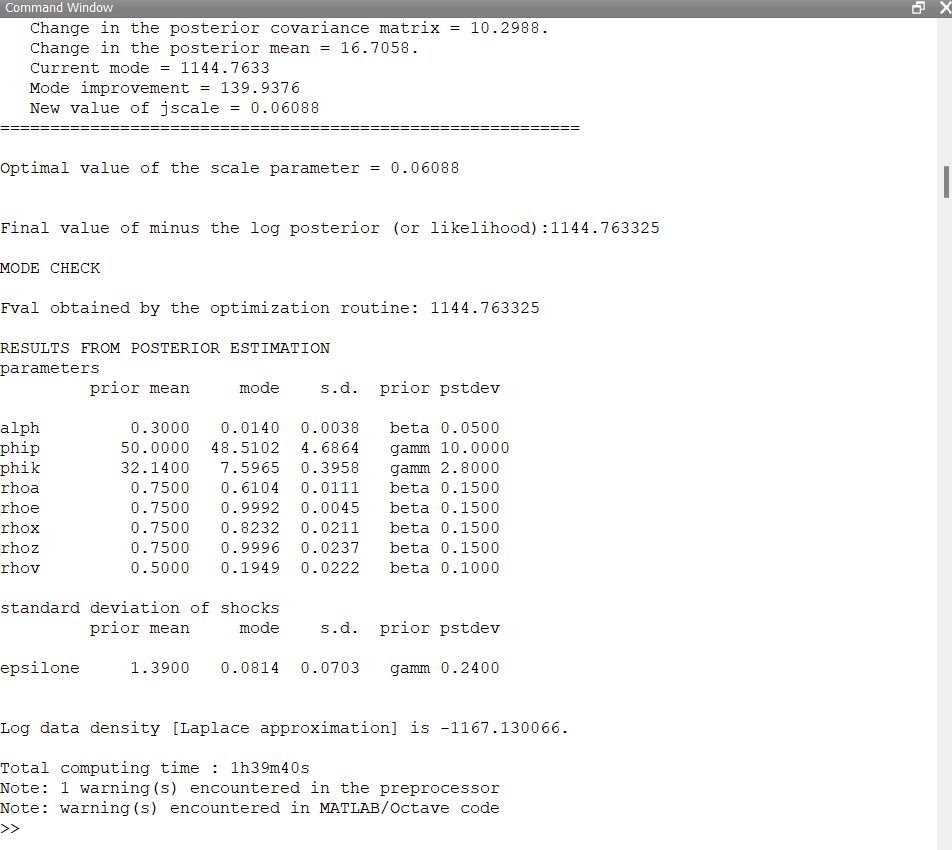- You should simply initialize every constant at 0.
- No, you need to leave the previous steady state and just add the steady state for the newly added variables.
- By having a separate constant parameter estimated in each observation equation.
Many thanks for reply. First, I’ve set the constants to 0 and added equations to the previous steady state.
Second, I’m not sure how to have a separate constant parameter in each observation equation. Does this mean I can’t have repeated “ctrend” in several equations?
The error message I obtain is in the attachemnt. Thanks.
Model.mod (3.4 KB)
It should be like the attached: Model1113.mod (3.5 KB)
Perfect, the code seems to work now, even though I obtain an error message that my Hessian matrix is not positive definite:
OPTIMIZATION PROBLEM!
(minus) the hessian matrix at the “mode” is not positive definite!
ᨀLog data density [Laplace approximation] is NaN.
error: chol: input matrix must be positive definite
How would I run Random Walk Metropolis-Hastings logarythm now? According to Dynare Reference Manual: 4.14 Estimation, I should use command:
posterior_sampling_method='random_walk_metropolis_hastings'
Does this mean I can add the line above as an option to estimation command? Thank you.
If mh_replic>0, the RW-MH will automatically start if you get a positive definite Hessian matrix.
Okay, I already have mh_replic=250000. Could you please confirm if my RW-MH runs correctly? I still obtain some error messages, although the process seems to run smoothy regardless. Thank you!
Model.mod (3.5 KB)
You did not declare endogenous variables after the estimation/calib_smoother command.
warning: Some of the parameters have no value (lne, lnz) when using initial_estimation_checks
. If these parameters are not initialized in a steadystate file or a steady_state_model-block
, Dynare may not be able to solve the model. Note that simul, perfect_foresight_setup, and pe
rfect_foresight_solver do not automatically call the steady state file.
As shown in the manual, you need to pick a number for mh_replic, e.g. mh_replic=100000.
Okay, I already have mh_replic=250000. Could you please confirm if my RW-MH runs correctly? I still obtain some error messages, although the process seems to run smoothy regardless. Thank you!
Model.mod (3.5 KB)
You did not declare endogenous variables after the estimation/calib_smoother command.
warning: Some of the parameters have no value (lne, lnz) when using initial_estimation_checks. If these parameters are not initialized in a steadystate file or a teady_state_model-block, Dynare may not be able to solve the model. Note that simul, perfect_foresight_setup, and perfect_foresight_solver do not automatically call the steady state file.
warning: gmhmaxlik: Unknown option (MaxIter)!
warning: called from
gmhmaxlik at line 59 column 13
Those are warnings you can ignore.
Perfect, after almost a year my file finally works, thanks to you! Many thanks for providing help for free without charging students!
Dear professor,
I have to compute full sample maximum likelihood estimates of the parameters, as well as standard errors, using parametric bootstrapping procedure. I can’t find any examples of this on the forum and my RW-MH algorithm computes only estimates of certain parameters. Could you please advise me how to write the code? Thanks.
Model.mod (3.5 KB)
I am not sure I understand the point. If you find a valid mode, you can do a Laplace approximation at the mode to obtain the standard errors at the mode for the estimated parameters.
Here is the paper that I am trying to replicate, please see pages 12/27 and 13/27.
Jerger Roehe 2011.pdf (261.6 KB)
I’m not sure how to do Laplace approximation, I followed this link: Laplace approximation - #2 by MichelJuillard
and set mh_replic=0, however I still obtain only estimates of 8 parameters, please see printscreen attached.
- If you really want to follow that paper, you need to program it yourself by simulating the model after estimation and then estimating the model again on that simulated data.
- You only estimate 8 parameters, of course you only get results for 8 parameters.
-
Thank you, regarding parameters, on page 13/27 that paper includes also e and z as parameters, although they’re variables. I obtain error messages, if I include them in the parameter section. How would I estimate these “parameters”?
-
Regarding simulating the model, that paper refers to Ireland 2007 paper, that uses Kalman filtering for simulation. So, can I use command for Kalman filter: lik_init = INTEGER from Dynare manual page 74/223? Thank you.
Model.mod (3.8 KB)
I don’t know what is going on in the paper. The estimation results look strange. The HP filtering of the data (which is a no-go) should demean the observed series. Estimating the means of the exogenous processes should be impossible then.,
So if HP filtering is a no-go, I’m not supposed to do HP filtering that you recommended and I can simply use raw observations data?
The authors of the paper quote De Jong, who emphasised need to do HP filtering on page 10/32:
De Jong ch3.pdf (475.4 KB)
It depends on what you are using the HP filter for. You are not supposed to use it for estimating data with a Kalman filter. See e.g.
Okay, thanks, so one-sided HP filter is also a no-go, although you claim on your link that it can be used for estimation unlike two-sided filter?
The two-sided HP filter is a problem for estimation, not the one-sided one. The standard two-sided HP filter violates the causality, i.e. time-ordering, underlying the recursive state space solution of the model.

